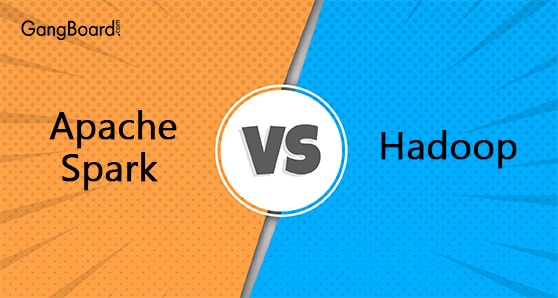
Apache Spark vs Hadoop
Apache Spark vs Hadoop
Spark and Hadoop are both the frameworks that provide essential tools that are much needed for performing the needs of Big Data related tasks. Of late, Spark has become preferred framework; however, if you are at a crossroad to decide which framework to choose in between the both, it is essential that you understand where each one of these lack and gain. This blog post aims to solve this purpose by making a comparison of both Hadoop and Spark.
Hadoop and Apache Spark – A Broad Picture
As an open source Big Data framework, Hadoop was the most preferred platform till the entry of Spark, its another counterpart from Apache. Though they are intended to serve the same purpose, they design and functionalities do not intersect fully. Another key feature of these two is they both can work together and have their own features that are dominantly useful in certain types of requirements.
Spark has gained lot of attention over Hadoop for one main reason – Speed. Spark carries its operations up to 100 times faster than Hadoop. This is attributed to the “in-memory” operations of Spark which reduces the time taken to write and read compared to Hadoop. In Spark, the data is stored in logical RAM memory unlike Hadoop which stores data in distributed storage system.
Another key aspect of Spark’s storage is that the data can be recovered with no loss after a failure, this is because the data sets of Spark are resiliently distributed.
Many Big Data systems such as those used in manufacturing industries need real time processing of data. This means as soon as the data is captured, it is to be fed into the application and insights are shared with the user. And the functionality of Spark is exactly this. This in-memory processing is another reason why developers prefer Spark over Hadoop.
But not everywhere does Hadoop lag behind. Hadoop has a key feature that Spark lacks – An its own distributed storage system. This is an essential feature in many of projects based on Big Data. The reason being huge memory being required to store ever increasing data that is being processed by Big Data applications. This own distributed storage system is also the reason behind scalability of applications designed using Hadoop.
Then what about storage if you opt for Spark instead of Hadoop? In such cases, it would be necessary to use a third party file system for storage of data. This is the reason you find many developers use install Spark and Hadoop to gain the advantages of both the frameworks. In such cases, internally Spark’s applications make use of Hadoop Distributed File System (HDFS).
Parametric Comparison
Now that we have seen in a broader sense what differs Spark and Hadoop, let’s delve into the parametric comparison of both the frameworks.
User Friendliness
Spark offers rich collection of APIs for Python, Java, Spark SQL and Scala. These are easier for users to learn and get started with. The shell of Spark is interactive and provided quick feedback for the programmers.
The same is the case with Hadoop. To work with Hadoop, you need tools such as Sqoop and Flame. Users working on Hadoop should also know frameworks such as YARN and data warehousing component such as HIVE.
Processing Speed
As we have seen, Spark’s processing is much faster owing to its in-memory style of storage and accessing data. Besides, it can work faster with disk stored data too, making it a preferred technology for IoT based applications and financial transaction applications.
Hadoop’s Map-reduce is, on the other hand, not delicately focused for real time processing. Its main purpose was to store data on a distributed environment.
Cost Per unit Computation
With Hadoop, you need more disk space, since its storage functionality is based on disk based memory and storage. This means you need more systems for storage.
Coming to Spark, you may have to spend on powerful systems with good memory because its processing speed is faster. Thus, though the initial cost incurred on systems in higher when you opt for Spark, the cost per computation is lesser compared to that when you use Hadoop.
Availability
The availability of Hadoop is based on HDFS and YARN, where master daemons check the health of slave daemons, which though effective causes longer completion times of operations.
On the other hand, Spark’s availability is based on its resiliently distributed datasets, which makes availability ten times as much faster than that of Hadoop.
Authentication and Encryption
Hadoop uses Lightweight Directory Access Protocol (LDAP) based authentication and encryption. The Hadoop distributed File Storage supports all standard file permissions and access control lists.
Spark’s authentication is a technique based on shared secret. It too can use HDFS access control lists and permissions at file level.
The Conclusion
If your project is based on structured data such as customer’s names and addresses, Hadoop would suffice. Your job would be done at reduced price at without any external need of installing Spark over Hadoop which just means more cost and time. Besides, Spark’s security and support needs more betterment.
The conclusion can be it would be the best if you can use both Spark and Hadoop at a time to gain from the faster processing speed of Spark, its advanced analytics and excellent integration support, with the cost effectiveness of Hadoop.
Now that it is proven that both Hadoop and Spark should go hand in hand and only one cannot suffice, why wait? Join the leader in Apache Spark and Apache Hadoop Online Training, GangBoard. Be trained from expert trainers here and grab you next dream job with confidence. All the best!


 +1 201-949-7520
+1 201-949-7520 +91-9707 240 250
+91-9707 240 250